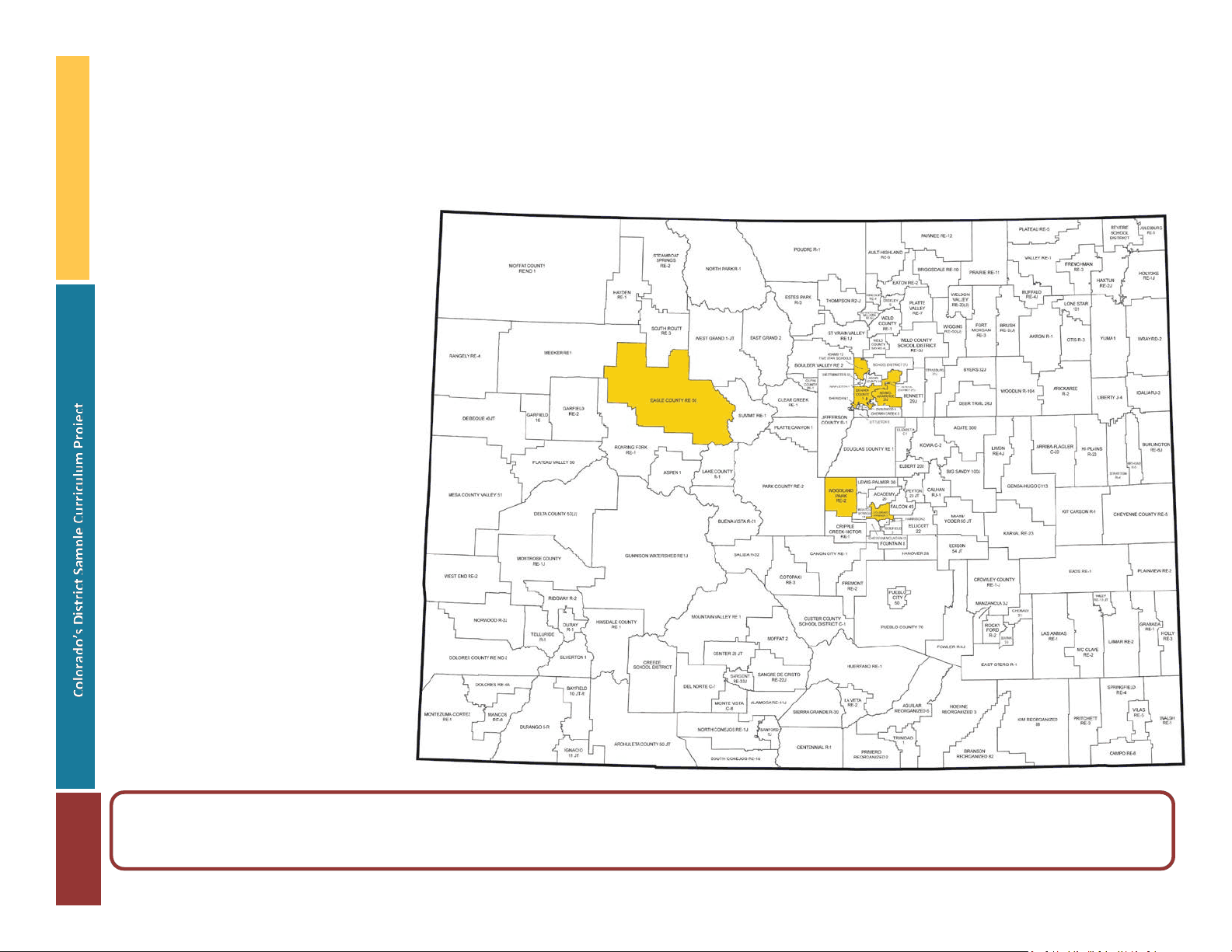
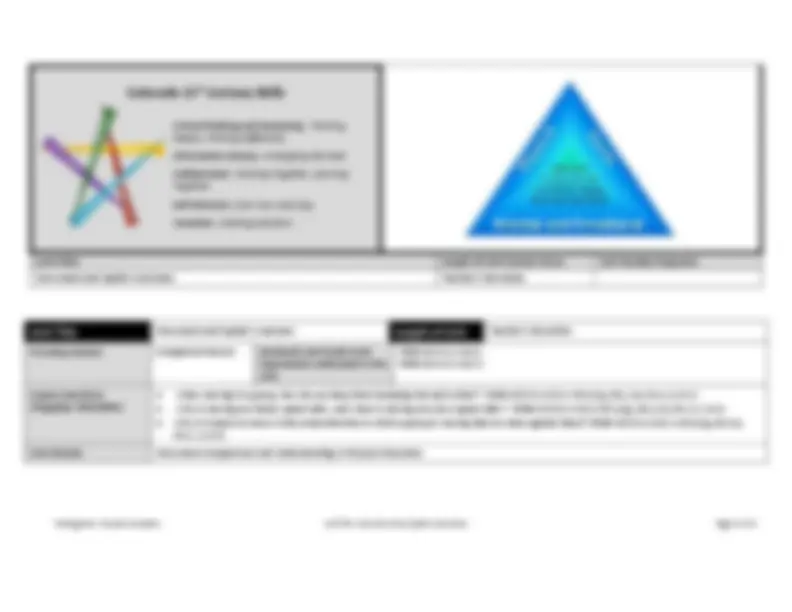
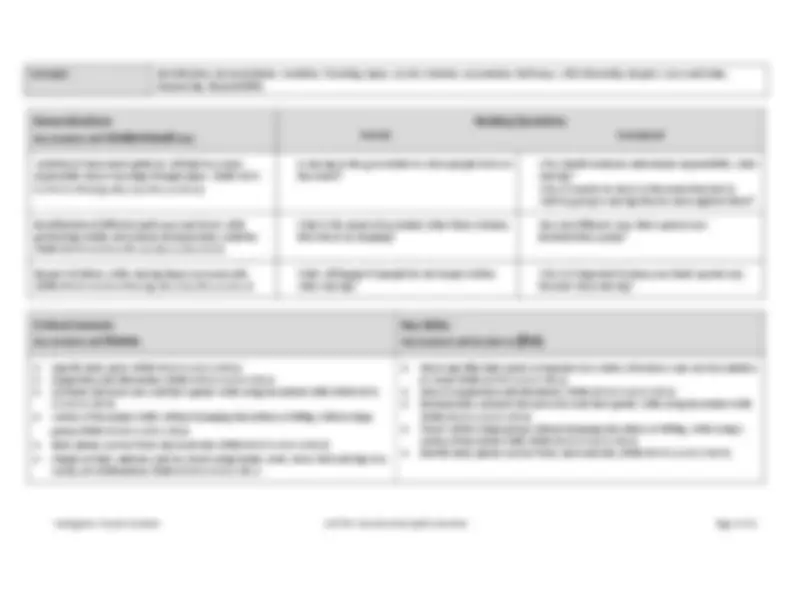
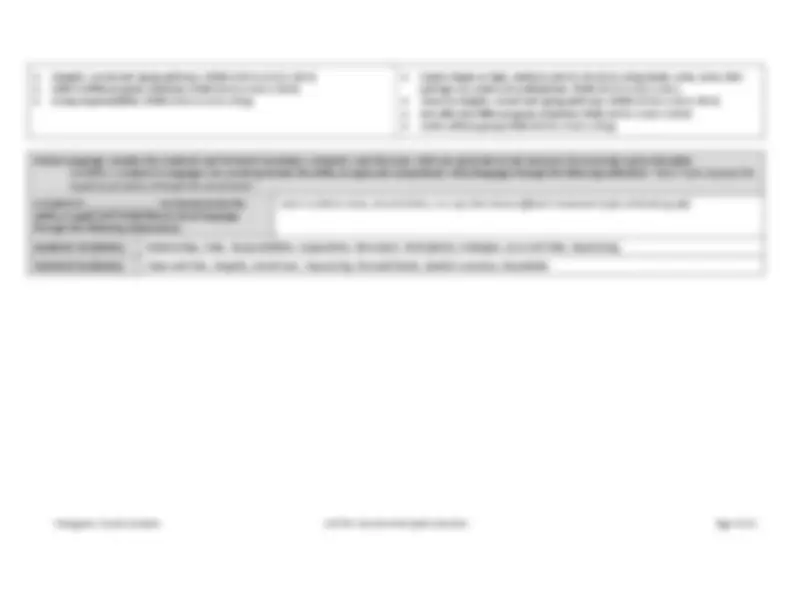
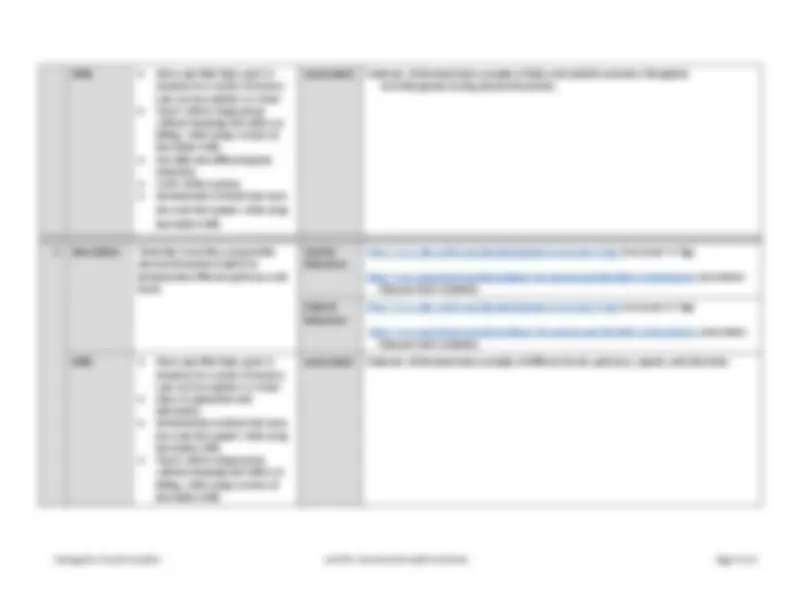
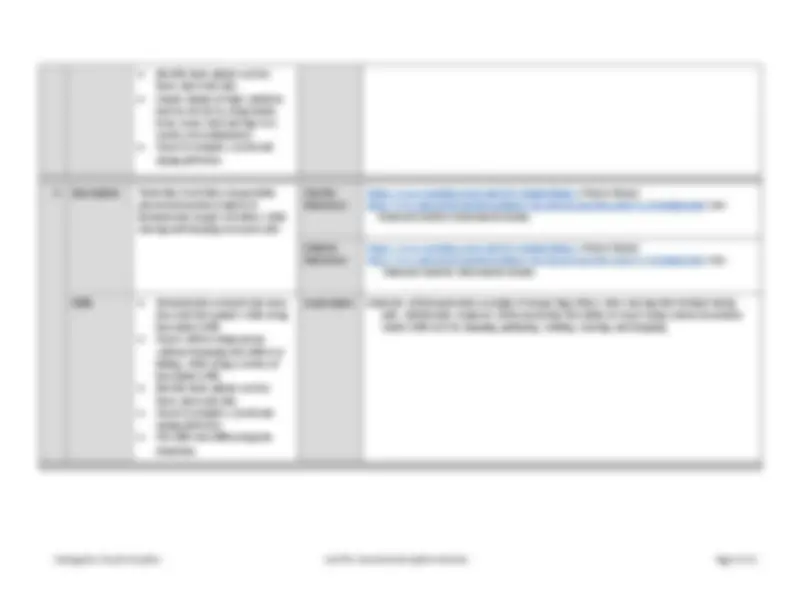
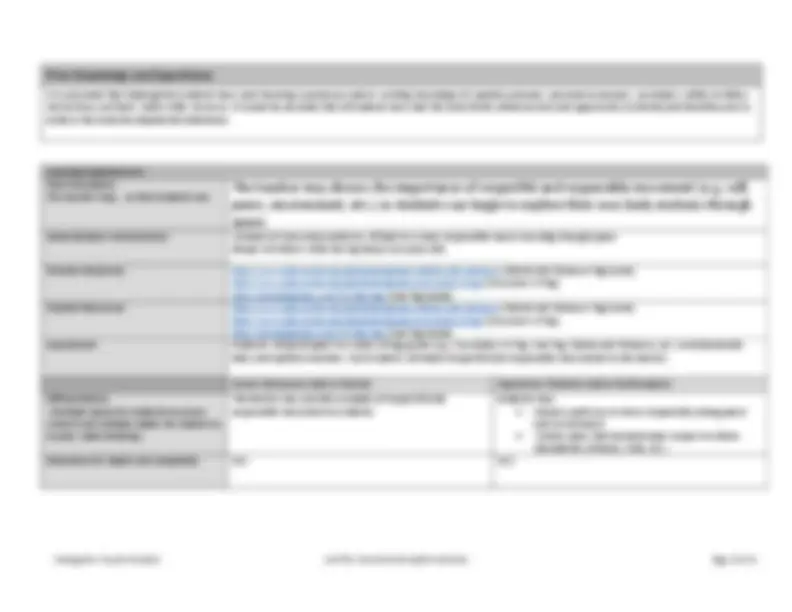
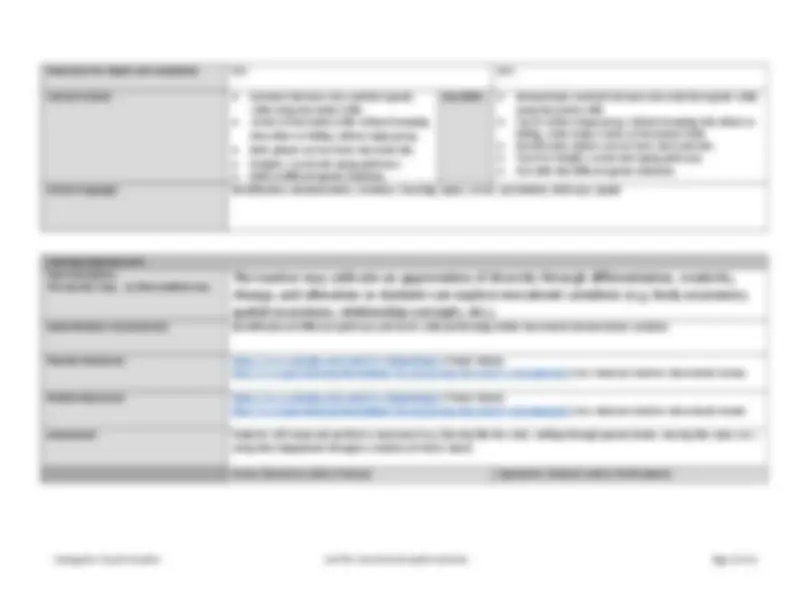
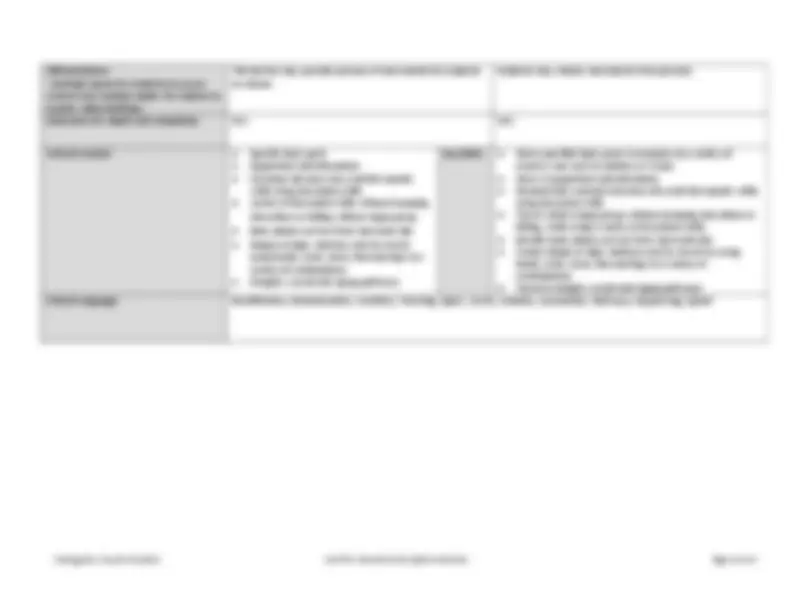


Study with the several resources on Docsity

Earn points by helping other students or get them with a premium plan


Prepare for your exams
Study with the several resources on Docsity

Earn points to download
Earn points by helping other students or get them with a premium plan
Community
Ask the community for help and clear up your study doubts
Discover the best universities in your country according to Docsity users
Free resources
Download our free guides on studying techniques, anxiety management strategies, and thesis advice from Docsity tutors
A teacher-authored instructional unit for kindergarten Physical Education focusing on Movement and Spatial Awareness. The unit includes Colorado Grade Level Expectations (GLEs), 21st Century Skills, concepts, generalizations, guiding questions, and skills. It also provides examples of elements in travel, differentiation, texts for independent reading, and assessment methods.
Typology: Study notes
1 / 14

This page cannot be seen from the preview
Don't miss anything!









Colorado Teacher-Authored Instructional Unit Sample
Physical Education
Kindergarten
Content Area Physical Education Grade Level Kindergarten
Relationships with Others Movement and Spatial Awareness
Standard Grade Level Expectations (GLE) GLE Code
Movement Competence and Understanding
Physical and Personal
Wellness
1.Understand that physical activity increases the heart rate, making the heart stronger PE09-GR.k-S.2-GLE.
Emotional and Social
Wellness
1.Demonstrate respect for self, others, and equipment PE09-GR.k-S.3-GLE. 2.Demonstrate the ability to follow directions PE09-GR.k-S.3-GLE.
Prevention and Risk Management
Expectations for this standard are integrated into the other standards at this grade level movement control for safe participation in games and sports
Concepts Identification, Demonstration, Variation, Traveling, Space, Levels, Creation, Locomotion, Pathways, (All) Citizenship, Respect, Laws and Rules, Sequencing, Responsibility
My students will Understand that…
Factual Conceptual
Variation of movement patterns will lead to a more responsible mover traveling through space. (PE09-GR.k- S.1-GLE.1-EO.a,f,g; IQ.1,3,4; RA.1,2; N.1,2)
Is moving in the gym similar to when people drive on the street?
Why should someone understand responsibility when moving? Why is it easier to move in the same direction in which a group is moving than to move against them?
Identification of different pathways and levels while performing similar movements demonstrates variation. (PE09-GR.k-S.1-GLE.1-EO.c,d; IQ.1,2; RA.3; N.3)
What is the name of an animal, other than a human, that moves by hopping?
How are different ways that a person can demonstrate a jump?
Respect of others while moving keeps everyone safe. (PE09-GR.k-S.1-GLE.1-EO.a,f,g; IQ.1,3,4; RA.1,2; N.1,2)
What will happen if people do not respect others when moving?
Why is it important to keep your head up and eyes forward when moving?
My students will Know…
My students will be able to (Do)…
● Specific body parts (PE09-GR.k-S.1-GLE.2-EO.a) ● Opposition and alternation (PE09-GR.k-S.1-GLE.1-EO.e) ● Contrasts between slow and fast speeds while using locomotor skills (PE09-GR.k- S.1-GLE.1-EO.b) ● Variety of locomotor skills without bumping into others or falling within a large group (PE09-GR.k-S.1-GLE.1-EO.a) ● Body planes such as front, back and side (PE09-GR.k-S.1-GLE.2-EO.b) ● Shapes at high, medium, and low levels using hands, arms, torso, feet and legs in a variety of combinations (PE09-GR.k-S.1-GLE.1-EO.c)
● Move specified body parts in response to a variety of sensory cues such as auditory or visual (PE09-GR.k-S.1-GLE.2-EO.a) ● Move in opposition and alternately (PE09-GR.k-S.1-GLE.1-EO.e) ● Demonstrate contrasts between slow and fast speeds while using locomotor skills (PE09-GR.k-S.1-GLE.1-EO.b) ● Travel within a large group without bumping into others or falling, while using a variety of locomotor skills (PE09-GR.k-S.1-GLE.1-EO.a) ● Identify body planes such as front, back and side (PE09-GR.k-S.1-GLE.2-EO.b)
● Straight, curved and zigzag pathways (PE09-GR.k-S.1-GLE.1-EO.d) ● Skills in different game situations (PE09-GR.k-S.1-GLE.1-EO.d) ● Group responsibilities (PE09-GR.k-S.1-GLE.1-EO.g)
● Create shapes at high, medium, and low levels by using hands, arms, torso, feet and legs in a variety of combinations (PE09-GR.k-S.1-GLE.1-EO.c) ● Travel in straight, curved and zigzag pathways (PE09-GR.k-S.1-GLE.1-EO.d) ● Put skills into different game situations (PE09-GR.k-S.1-GLE.1-EO.d) ● Work within a group (PE09-GR.k-S.1-GLE.1-EO.g)
Critical Language: includes the Academic and Technical vocabulary, semantics, and discourse which are particular to and necessary for accessing a given discipline. EXAMPLE: A student in Language Arts can demonstrate the ability to apply and comprehend critical language through the following statement: “Mark Twain exposes the hypocrisy of slavery through the use of satire.”
A student in ______________ can demonstrate the ability to apply and comprehend critical language through the following statement(s):
Aaron is able to move, around others, in a way that shows different movement styles while being safe.
Academic Vocabulary: Relationships, Rules, Responsibilities, Cooperation, Movement, Participation, Strategies, Laws and Rules, Sequencing,
Technical Vocabulary: Chase-and-Flee, Empathy, Social Cues, Sequencing, Personal Needs, Spatial Awareness, Boundaries
● Hurdles ● Hoops ● Tunnel ● Cones ● Mats Differentiation: (Multiple modes for student expression)
Students may: ● dress as the animated character ● perform one on one with the teacher ● discuss one on one with the teacher ● work with a partner to develop the movement/skill
Informational/Non-Fiction Fiction Ages & Stages: All About Body Awareness by Carla Poole, Susan A. Miller 7, Ellen Booth Church (Lexile 550) Baseball Saved Us by Ken Mochizuki (Lexile 550)
Personal Space Camp by Julia Cook (Lexile range 300-500) LUCY IN THE CITY: A STORY ABOUT DEVELOPING SPATIAL THINKING SKILLS, by Julie Dillemuth (Lexile 250) ROSIE’S WALK, Pat Hutchins Macmillan (Lexile 200-250) That Rule Doesn’t Apply to Me! by Julia Cook (Lexile 200-250) Play Ball, Amelia, Bedelia by Peggy Parish (Lexile 220) Jump! by Scott M. Fischer (Lexile 250)
Teacher Resources:
http://www.pecentral.org/lessonideas/ViewLesson.asp?ID=9471#.WEMF97IrLIU (Hula Hoop Car Road Trip Variation) http://www.pecentral.com/lessonideas/ViewLesson.asp?ID=11920#.WEMdxKIrIU (Locomotor Movement Game) Student Resources:
http://www.pecentral.org/lessonideas/ViewLesson.asp?ID=9471#.WEMF97IrLIU (Hula Hoop Car Road Trip Variation) http://www.pecentral.com/lessonideas/ViewLesson.asp?ID=11920#.WEMdxKIrIU (Locomotor Movement Game)
Skills: ● Move specified body parts in response to a variety of sensory cues such as auditory or visual. ● Travel within a large group without bumping into others or falling, while using a variety of locomotor skills. ● Put skills into different game situations. ● Work within a group. ● Demonstrate contrasts between slow and fast speeds while using locomotor skills.
Assessment: Students will demonstrate examples of body and spatial awareness throughout activities/games during physical education.
Teacher Resources:
http://www.playworks.org/playbook/games/everyones-it-tag (Everyone’s It Tag)
http://www.pecentral.com/lessonideas/ViewLesson.asp?ID=495#.WEMZmrIrLIU (Locomotor Treasure Hunt Variation) Student Resources:
http://www.playworks.org/playbook/games/everyones-it-tag (Everyone’s It Tag)
http://www.pecentral.com/lessonideas/ViewLesson.asp?ID=495#.WEMZmrIrLIU (Locomotor Treasure Hunt Variation) Skills: ● Move specified body parts in response to a variety of sensory cues such as auditory or visual. ● Move in opposition and alternately. ● Demonstrate contrasts between slow and fast speeds while using locomotor skills. ● Travel within a large group without bumping into others or falling, while using a variety of locomotor skills.
Assessment: Students will demonstrate examples of different levels, pathways, speeds, and directions.
It is presumed that kindergarten students have prior learning experiences and/or working knowledge of: spatial awareness, personal awareness, vocabulary, ability to follow instructions, and basic motor skills. However, it cannot be assumed that all students have had the same family infrastructure and opportunity to attend preschool/daycare to achieve the same developmental milestones.
Learning Experience # 1 Task Description: The teacher may… so that students can…
The teacher may discuss the importance of respectful and responsible movement (e.g. self, peers, environment, etc.) so students can begin to explore their own body motions through space.
Generalization Connection(s): Variation of movement patterns will lead to a more responsible mover traveling through space. Respect of others while moving keeps everyone safe.
Teacher Resources: http://www.playworks.org/playbook/games/sharks-and-minnows (Sharks and Minnows Tag Game) http://www.playworks.org/playbook/games/everyones-it-tag (Everyone’s It Tag) http://physedgames.com/?s=line+tag (Line Tag Game) Student Resources: http://www.playworks.org/playbook/games/sharks-and-minnows (Sharks and Minnows Tag Game) http://www.playworks.org/playbook/games/everyones-it-tag (Everyone’s It Tag) http://physedgames.com/?s=line+tag (Line Tag Game) Assessment: Students will participate in a variety of tag games (e.g. Everybody's It Tag, Line Tag, Sharks and Minnows, etc.) to demonstrate body and spatial awareness. Each student will model respectful and responsible movements to the teacher.
Access (Resources and/or Process) Expression (Products and/or Performance)
Differentiation: (Multiple means for students to access content and multiple modes for student to express understanding.)
The teacher may provide examples of respectful and responsible movement to students.
Students may: ● choose a pathway to move responsibly among peers and environment ● choose space that demonstrates respect to others (boundaries, distance, time, etc.) Extensions for depth and complexity: N/A N/A
Critical Content: ● Specific body parts. ● Variety of locomotor skills without bumping into others or falling within a large group. ● Skills in different game situations. ● Group responsibilities. ● Contrasts between slow and fast speeds while using locomotor skills.
Key Skills: ● Move specified body parts in response to a variety of sensory cues such as auditory or visual. ● Travel within a large group without bumping into others or falling, while using a variety of locomotor skills. ● Put skills into different game situations. ● Work within a group. ● Demonstrate contrasts between slow and fast speeds while using locomotor skills. Critical Language: Demonstration, Space, Respect, Responsibility
Learning Experience # 2 Task Description: The teacher may… so that students can…
The teacher may introduce spatial concepts (e.g. personal, general, boundaries, etc.) so students can begin to apply during activities and games.
Generalization Connection(s): Variation of movement patterns will lead to a more responsible mover traveling through space.
Teacher Resources: http://www.pecentral.org/lessonideas/ViewLesson.asp?ID=9471#.WEMF97IrLIU (Hula Hoop Car Road Trip Variation) http://physedgames.com/?s=line+tag (Line Tag Game)
Student Resources: http://www.pecentral.org/lessonideas/ViewLesson.asp?ID=9471#.WEMF97IrLIU (Hula Hoop Car Road Trip Variation) http://physedgames.com/?s=line+tag (Line Tag Game)
Assessment: Students will participate in a variation of Hula Hoop Cars to demonstrate spatial awareness (e.g. lines, boundaries, speed, etc.). The activity requires students to navigate their environment.
Access (Resources and/or Process) Expression (Products and/or Performance)
Differentiation: (Multiple means for students to access content and multiple modes for student to express understanding.)
The teacher may: ● use visuals/pictures so students can change movements. ● provide a variety of equipment with different texture and sizes (hoops, frisbees, rings, etc.).
Students may: ● use pictures to participate in the movements. ● access a variety of equipment that meets their needs.
Extensions for depth and complexity: N/A N/A
Critical Content: ● Contrasts between slow and fast speeds while using locomotor skills. ● Variety of locomotor skills without bumping into others or falling within a large group. ● Body planes such as front, back and side. ● Straight, curved and zigzag pathways. ● Skills in different game situations.
Key Skills: ● Demonstrate contrasts between slow and fast speeds while using locomotor skills. ● Travel within a large group without bumping into others or falling, while using a variety of locomotor skills. ● Identify body planes such as front, back and side. ● Travel in straight, curved and zigzag pathways. ● Put skills into different game situations.
Critical Language: Identification, Demonstration, Variation, Traveling, Space, Levels, Locomotion, Pathways, Speed
Learning Experience # 4 Task Description: The teacher may… so that students can…
The teacher may cultivate an appreciation of diversity through differentiation, creativity, change, and alteration so students can explore movement variations (e.g. body awareness, spatial awareness, relationship concepts, etc.).
Generalization Connection(s): Identification of different pathways and levels while performing similar movements demonstrates variation.
Teacher Resources: https://www.youtube.com/watch?v=YbmeGiRuaCA (Freeze Dance) http://www.pecentral.org/lessonideas/ViewLesson.asp?ID=12627#.WEMm8aIrIU0 (Wax Museum Creative Movements Game)
Student Resources: https://www.youtube.com/watch?v=YbmeGiRuaCA (Freeze Dance) http://www.pecentral.org/lessonideas/ViewLesson.asp?ID=12627#.WEMm8aIrIU0 (Wax Museum Creative Movements Game)
Assessment: Students will create and perform a movement (e.g. blowing like the wind, walking through peanut butter, moving like water, etc.) using their imagination through a variation of Freeze Dance.
Access (Resources and/or Process) Expression (Products and/or Performance)
Differentiation: (Multiple means for students to access content and multiple modes for student to express understanding.)
The teacher may provide pictures of movements for students to choose.
Students may choose movements from pictures.
Extensions for depth and complexity: N/A N/A
Critical Content: ● Specific body parts ● Opposition and alternation ● Contrasts between slow and fast speeds while using locomotor skills ● Variety of locomotor skills without bumping into others or falling within a large group ● Body planes such as front, back and side ● Shapes at high, medium, and low levels using hands, arms, torso, feet and legs in a variety of combinations ● Straight, curved and zigzag pathways
Key Skills: ● Move specified body parts in response to a variety of sensory cues such as auditory or visual. ● Move in opposition and alternately. ● Demonstrate contrasts between slow and fast speeds while using locomotor skills. ● Travel within a large group without bumping into others or falling, while using a variety of locomotor skills. ● Identify body planes such as front, back and side. ● Create shapes at high, medium, and low levels by using hands, arms, torso, feet and legs in a variety of combinations. ● Travel in straight, curved and zigzag pathways. Critical Language: Identification, Demonstration, Variation, Traveling, Space, Levels, Creation, Locomotion, Pathways, Sequencing, Speed